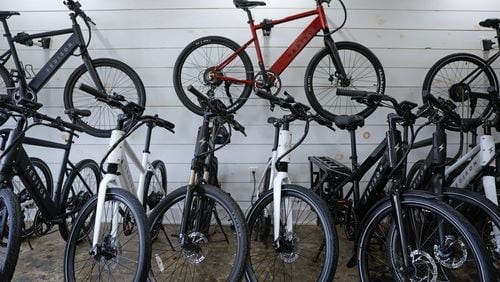One sweltering June morning, 22-year-old Mona Su woke up craving pho.
The eight-mile trip to Lee’s Bakery would take about 15 minutes by car from her Midtown apartment. Instead, Su recorded her journey on public transit, taking the MARTA gold line to Doraville then bus 39 to Buford Highway. After grabbing the grub, the bus wasn’t coming any time soon, so Su walked 45 minutes in the heat back to the MARTA station.
Altogether, a two hour round trip for a (delicious) bowl of noodle soup.
Although the trek may seem typical for those accustomed to Atlanta transit, the video is now one of Su’s most popular reels on her Instagram account where she shares a car-free lifestyle — joining a small, but growing, community of young creators promoting alternative modes of transportation in a city infamous for its urban sprawl and car-centric culture.
Atlanta ranks as the metro area with the 16th highest rate of vehicle ownership nationally, with about 94% of households having vehicle access, according to a 2020 U.S. Census American Community Survey.
Hundreds of commenters on similar videos debate the viability of living in the city without a private vehicle. Some critics point to MARTA’s lack of accessibility from certain parts of Atlanta.
The transit system has struggled with public perception amid declining popularity. From 2012 to 2022, MARTA’s ridership decreased by 60%, and this year’s numbers have yet to reach pre-pandemic levels.
“Our current MARTA rail system is underutilized, in part, because we don’t have enough stations located where our residents need them most,” Atlanta Mayor Andre Dickens said during his annual State of the City address this spring, where he announced plans for four new MARTA stations.
Yet as Atlanta officials continue a decades-long effort to strengthen transportation infrastructure, some young people are publicly exploring ways to ditch the car with the options at hand.
Car-free in ATL
Su moved to Atlanta last year for her first job after graduating college in North Carolina. She said she debated buying a car, but her mother convinced her to get settled into the city first.
While learning her way around Atlanta, Su discovered another Instagrammer, under the username “atlyimby,” posting reels about navigating the city’s transit system. She began making her own “day in the life” videos, centered around traveling without a car, that started to blow up.
“I was like, oh my gosh, people are actually interested in this,” Su said. “So that’s when I pivoted to more Atlanta lifestyle content. After I made the account, I realized that a lot of people actually don’t have cars, just like me.”
Along with guides showing viewers how to get to popular destinations on MARTA, Su offers a firsthand account of biking and scootering around the city.
Since purchasing a secondhand electric scooter for $300, Su estimates she saves around $450 a month without car payments. She averages about $150 a month on MARTA passes and the occasional Uber ride — in one post about attending a networking event, she wrote “sometimes the only realistic way to get places in Atlanta is with a car.”
Credit: Miguel Martinez
Credit: Miguel Martinez
For Atlantans living outside of Midtown — an area with relatively high rents compared to other neighborhoods — a lack of MARTA and biking infrastructure may force heavier car dependence.
The Atlanta Bicycle Coalition, also known as Propel, successfully lobbied for a new bike lane on Central Avenue, across from City Hall, and has added over three miles of protected bike lanes across the downtown. The city added a total of 42 multiuse paths or bike lanes between 2017 and 2022 and has planned over $300 million for related infrastructure projects.
Despite progress, Su said bike lanes often end, and she must decide whether to risk riding on the main road.
“I’ve tried biking outside of Midtown, and it’s very difficult because you have to go on the road, and it’s very dangerous with the cars,” Su said. “So I don’t love doing that, but sometimes that’s the only option. And I’ve noticed that there’s some bike lanes here and there, but it’s very sparse and not super consistent.”
And as far as the pho goes? While Su enjoyed her lunch, she said the outing was something she “definitely can’t do consistently.”
“Going out that far has to be a whole event, because you have to plan out so many hours in advance, and it’s just a lot of time being outside — especially in the summer.”
Atlanta transit girl
When 26-year-old Laura Dunn recalled her first time using MARTA as a child growing up in Gwinnett, she remembered stepping off the train car and into a crowd of people from all socioeconomic backgrounds, races and identities, “all in one space.”
Now living in the Old Fourth Ward area, Dunn creates short videos on her Instagram account, “atlantatransitgirl” to share the vibrant culture she found through public transportation. Her content features colorful outfits and conversations with other riders she meets along the way, supplemented with tips for feeling safe as a Black woman on transit.
Credit: Seeger Gray / AJC
Credit: Seeger Gray / AJC
Dunn said she hopes her small platform will inspire viewers to rethink their relationships with MARTA.
“In other places around the world, it’s so normal to use public transportation,” Dunn said. “But it seems like it’s like pulling teeth here in the south. And I felt like a lot of social, economic and racial tension ties into people’s viewpoints, so I wanted to show them: What is the real-life experience of an everyday rider?”
Despite giving her car away to a relative for financial reasons when she first moved to the area, Dunn recently started a job in Clayton County that forced her to rely on a car again.
According to the Georgia Public Policy Foundation, only 38% of working-age metro Atlantans have access to public transit and only 22% of jobs are located within a 90-minute commute on public transit.
“Unless your job is concentrated in the city center, you definitely need a car,” Dunn said. “Because there’s no way to walk or have the frequency of transportation going to a lot of places outside of what’s considered metro Atlanta.”
The 35-minute commute behind the wheel leaves Dunn feeling drained, and she said she misses the spontaneous social interactions on public transit. However, Dunn resigned from her job last month and plans to become more active both on social media and as a MARTA rider.
Through her account, Dunn has connected with local advocacy groups and recently participated in a panel on the relationship between cost of living and public transportation. Especially after spending time in Clayton County, she has seen residents who cannot afford private vehicles and must walk dangerous routes to access transit stations.
“To even have the idea to walk or be able to use public transportation, you’re probably spending a lot of money to live within the city to even have that option,” Dunn said. “So there’s definitely a lot of inequality within development.”
Atlanta in my backyard
Ian Samuels was sitting in a train car along his daily commute when a MARTA employee suddenly approached the 23-year-old.
“I love your content,” Samules remembers the employee telling him last month. “They were playing one of your videos in one of our training sessions.”
For some, Samuels serves as Atlanta’s O.G. “car-free” creator. A brief scroll through his TikTok, “atlimby,” offers a living guidebook to the city’s public transit — and, apparently for some MARTA employees, an inside look at how residents interact with the rail and bus system.
A recent Georgia State graduate, Samuels started creating videos last year after friends asked for advice getting to different public events. Samuels said he also wanted to share his perspective on a city that sometimes gets a bad rap.
“When I’m scrolling through TikTok, people are complaining they’re stuck in traffic, Atlanta sucks, there’s crime everywhere — there’s all these negative depictions of Atlanta,” Samuels said. “It’s like, why don’t I share my story and how I get around?”
Credit: Steve Schaefer /
Credit: Steve Schaefer /
Samuels later expanded his account to Instagram, where he has noticed comments skew more inflammatory in tone. He doesn’t take it personally. He said much of the negativity seems like an outlet for general frustration with traffic and larger public transportation debates.
In any case, more interaction leads to more views.
After uploading an early video outlining a trip to Kroger, Samuels received several concerned comments that he did not record his transfer at the Five Points station.
“That’s not really a big deal in my mind, as someone who uses MARTA every day,” Samuels said. “But I realized I need to add more context to my videos, because a lot of people truly have never been on MARTA. It’s kind of like knowing how to drive — it’s not intuitive necessarily to a lot of people.”
Although he identifies as a longtime public transit fan, Samuels said many people have a love-hate relationship with the system. He lives downtown but emphasized that access to transportation can drastically vary depending on location.
And not everyone has the option of affording a car. To expand accessibility, Samuels advocated for expanded payment options like the fare-capping systems implemented in other cities. He also said he is encouraged by plans for new MARTA stations and the Campbellton Road BRT line.
“Gen Z, we’re seeing a trend where we really don’t want to drive as much as other generations, and we like to be in walkable areas,” Samuels said. “So I think there’s an untapped potential for people under 30 — post grads, young adults, college students, high schoolers, middle schoolers — to get into public transit.”
“Hopefully everyone wants to get on board, but especially young people, because we are the future.”
About the Author









